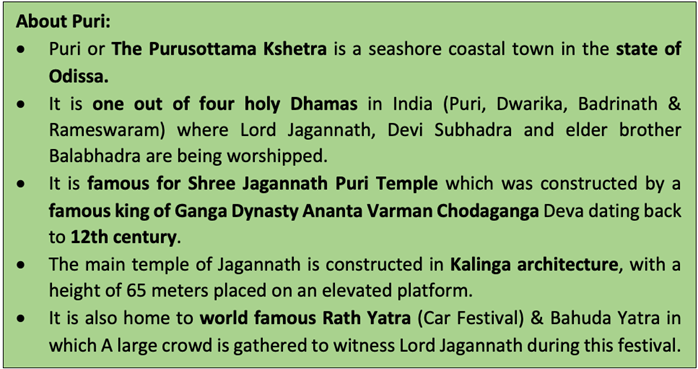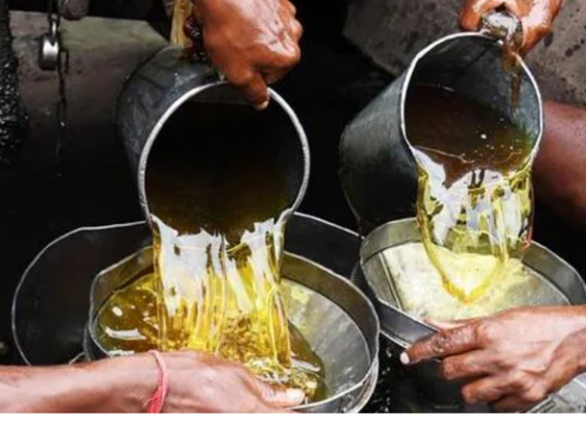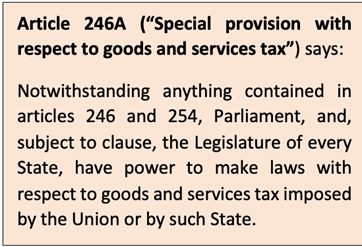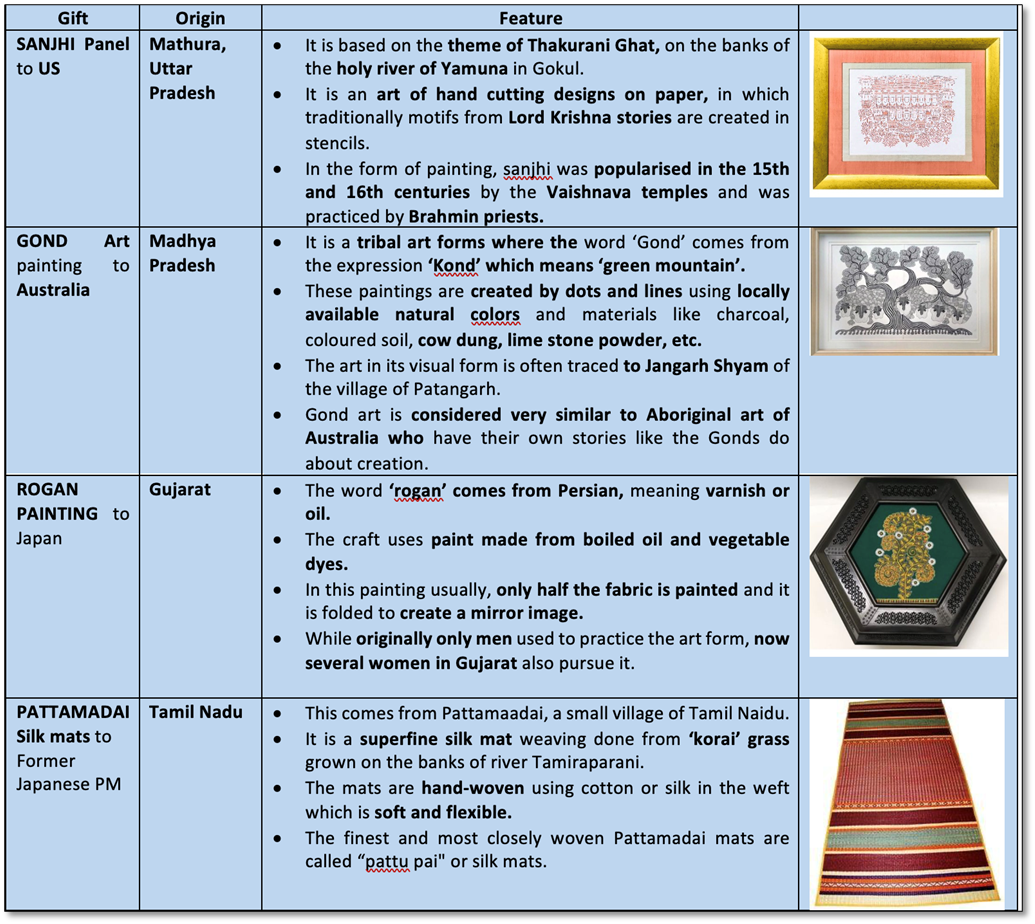Monday, 6th June 2022
Electric Vertical Take-off and Landing (eVTOL)
In News
The Government of India is exploring the possibility of inviting manufacturers of Electric Vertical Take-off and Landing (eVTOL) aircraft to set up base in India.
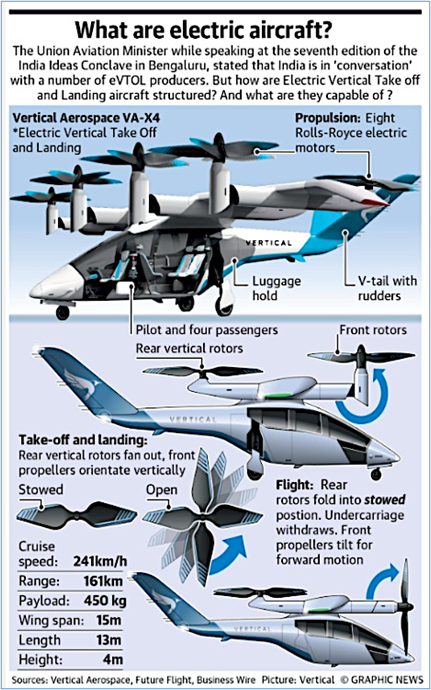
About the News:
- The Union Civil Aviation Minister had been on a visit to the U.S. and Canada in April to look into the possibilies of Electric Vertical Take-off and Landing (eVTOL) aircraft to set up base in India.
- Several eVTOL players were ‘keen on setting up production centres’ in the country with an implication on a futuristic vision for India.
What is eVTOL?
- An electric vertical take-off and landing (eVTOL) aircraft is a new development in aircraft technology that uses electric power to hover, take off, and land vertically.
- Most eVTOLs also use what is called as distributed electric propulsion technology integrating multiple motors for various functions; to increase efficiency; and to also ensure safety.
- Development of eVTOLs is contingent on the successes in electric propulsion based on progress in motor, battery, fuel cell and electronic controller technologies and also fuelled by the need for new vehicle technology that ensures urban air mobility (UAM).
Advantages of eVTOLs
- It has the potential to bring the cost down over traditional helicopters, reducing maintenance costs, reducing noise, and having no exhaust pollution.
- A motivation for eVTOL research is the desire to offer cheaper air mobility in urban environments.
- Another benefit of eVTOLs is that extensive infrastructure does not need to be in place for it to be adopted. Only transportation hubs need to be built, with no need to build roads or tracks to support it unlike electric road vehicles, that require charging stations, or overhead wiring to power or charge vehicles on the go.
- With access to fast and efficient mobility, UAM could potentially help decrease the population density of a city by encouraging people to move to the surrounding suburban areas and offering them quick ways to travel into the city for work.
Challenges in adoption of eVTOLs:
- Crash Prevention: Crash prevention systems need to use cameras, radar, GPS (global positioning system) and infrared scanners. There are also issues such as ensuring safety in case of powerplant or rotor failure.
- Cyberattacks: Electric mobility raises an issue of cyberattacks. Air travel becomes particularly unsafe in case of such attacks.
- Unsafe environment and risky terrain: Navigation and flight safety will be challenging operating in difficult terrain, unsafe operating environments and also bad weather.
- Battery Technology: Battery pack sizing and safety play a major role in the overall weight of the craft, and engineers must first optimize these considerations before the use of eVTOLs becomes widespread.
- Air traffic regulations: Air traffic is also much more heavily regulated than road traffic, meaning that policies and regulations need to be ironed out and tested before this type of transportation can be safely opened to the public.
Sources:
Rajya Sabha elections
In News
Recently, Parliament witnessed elections for vacant seats in its Rajya Sabha.
About the News
- Every two years nearly 33 percent of the seats in the upper house or the Rajya Sabha in India goes vacant for fresh elections.
- Elections for these members of the Rajya Sabha is done through indirect elections through the proportional representation process with the single transferable vote (STV) system.
- Recently, elections to 57 seats in Rajya Sabha, spread across 15 states and Union territories, are slated to be held in Parliament.
What are the important features of election in the Rajya Sabha?
- Selection of members: Rajya Sabha members are chosen through indirect elections with only elected members of legislative Assemblies or MLAs vote for members.
- Tenure: Every elected member serves for 6 years instead of the five years as in case of a Lok Sabha member.
- Voting points: Each state is allocated a certain number of candidates in the Rajya Sabha based on its population. Whenever a new state is created or multiple states are merged, the makeup of the Rajya Sabha also changes.
- Seats: As per the Constitution there is an upper limit to the number of members in the Rajya Sabha — 250. Currently there are 245 members (including vacancies) in the House, with 12 of these members being nominated by the President.
- Chairperson: The Vice-President of India is the chairperson of the Rajya Sabha.
- Inevitable situation: Vacancies arise in the interim due to death, disqualification and resignations are filled up through by polls.
- Casual vacancy: As per Section 154 of the Representation of the People Act 1951, a member chosen to fill a casual vacancy will serve for the remainder of his predecessor's term of office.
How are members elected in the Rajya Sabha?
- Mechanism: In Rajya Sabha election, instead of directly voting for each seat, the Lok Sabha MPs list all the candidates standing for election in order of preference for being elected. Each MLA’s vote is counted only once. But MLAs don’t vote for each seat.
- Proposal: Candidates fielded by political parties have to be proposed by at least 10 members of the Assembly or 10% of the party’s strength in the House, whichever is less. For independents, there should be 10 proposers, all of whom should be members of the Assembly.
- Preference system: Candidate is selected as the first preference by 10 or more Lok Sabha members, they are directly elected with each candidate needing one-fourth of the total vote plus one to be elected.
- Transferable voting: As candidates are elected, the ‘surplus’ votes of MLAs are transferred to the next candidates’ kitty, but with a diminished value. This is important as it allows MLAs to vote for candidates from other parties.
- UTs with legislature: The Delhi and Puducherry Assemblies elect members to the Rajya Sabha to represent the two Union Territories.
Important features in Rajya Sabha election:
- Checking corruption: To stop cross-voting induced by corruption, each MLA must show his or her vote to an authorised agent of the party. If an MLA does not show his or her ballot to the agent, the vote cannot be counted.
- None of the above, or NOTA: As per the Election Commission of India (ECI) gives Rajya Sabha members the option to press the NOTA button in the Upper House polls which was later struck down by the Supreme Court.
- Cross-voting: The Supreme Court has ruled that not voting for the party candidate will not attract disqualification under the anti-defection law. As voters, MLAs retain their freedom to vote for a candidate of their choice. However, the parties are free to take disciplinary action against the legislator concerned.
- Oath without membership: While taking oath as a member is for anyone to function as a legislator, the Supreme Court has ruled that a member can vote in a Rajya Sabha election even before taking oath as legislator. Further, a member can also propose a candidate before taking oath.
Sources:
Liquid-mirror telescope
In News
Devasthal Observatory campus owned by Aryabhatta Research Institute of Observational Sciences (ARIES), Nainital in Uttarakhand has recently set-up the International Liquid-Mirror Telescope (ILMT).
About the News
- The telescope will observe asteroids, supernovae, space debris and all other celestial objects from an altitude of 2,450 metres in the Himalayas.
- Having entered the commissioning phase, it has become the world’s first and India’s first liquid-mirror telescope to be commissioned for astronomy.

- The liquid-telescopes that were previously built either tracked satellites or were deployed for military purposes.
- ILMT will be the third telescope facility to come up at Devasthal.
- Devasthal is one of the world’s pristine sites for obtaining astronomical observations.
- Devasthal Optical Telescope (DOT)and Devasthal Fast Optical Telescope (DFOT) are the other two telescope facilities at Devasthal.
- ILMT is set to commence at full-scale scientific operations in October this year.
- It will work along with the 6-metre Devasthal Optical Telescope (DOT), the largest telescopes operating in India (of the 4-metre class).
- The countries involved in ILMT’s development include India, Belgium, Canada, Poland and Uzbekistan.
How is ILMT different from a conventional telescope?
- A LMT is a stationarytelescope whereas a conventional telescope moves along the direction of the object of interest in the sky.
- A LMT will survey and capture any and all possible celestial objectssuch as stars, galaxies, supernovae explosions, asteroids and even space debris. However, a conventional captures just a piece of sky at a given point of time.
- LMT comprises mirrors with a reflective liquid (ILMT has mercury as reflective liquid).On the other hand, a conventional telescope uses highly-polished glass mirrors.
- While ILMT will be capturing images of the sky on all nights, conventional telescopes observe specific objects in the sky for fixed hours only.
Source:
- Explained: As India gets world’s first liquid-mirror telescope for astronomy, what is it and how will it be used?
- India Gets Its 1st Liquid Mirror Telescope, To Track Debris From Space
Image source:
Operation Blue star
On June 6, 1984, Operation Blue Star was carried out by the Indian Army on to flush out militants from the Golden Temple, the holiest shrine of Sikhism. Indira Gandhi, the then Prime Minister of India, ordered the military operation to remove Sikh militants who were accumulating weapons in the Harmandir Sahib Complex (Golden Temple). Operation Blue Star took birth after the rise of Khalistan movement in India.
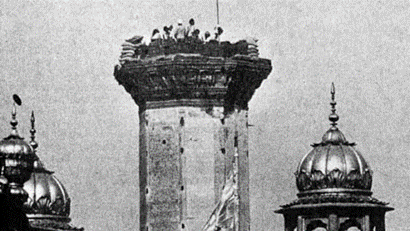
The Khalistan movement was a political Sikh nationalist movement which aimed at creating an independent state for Sikhs inside the current North-Western Republic of India. Bhindranwale was the leader of Damdami Taksal and was one of the main reasons behind Operation Blue Star. Operation Blue Star specifically was aimed to eliminate Jarnail Singh Bhindranwale from the Golden Temple complex and regain the control over Harmandir Sahib. The government faced a lot of backlash in 1984 as they had barred media from entering Punjab altogether.
Source:
Sologamy
- Context: A 24-year-old Vadodara woman has recently announced that she would marry herself later this month describing it as an “act of self-love”.
- This is being seen as one of the first instances of self-marriage or “sologamy” in the country.
- Sologamy is the act of marrying oneself in a public ceremony, also referred to as self-marriage or autogamy. While such a marriage has no legal sanction or status, the symbolic ceremony is used by many as an act to emphasize their self-love and independence.
- The trend began, when a woman from USA married herself in 1993.

- The trend is finding resonance now due to: Independent status of women, their ability to earn, love and have children, if they chose to do so, breaking stereotypes, and the inspiration to love oneself.
- The Hindu Marriage Act uses the terminology 'either of the spouse', which simply means that there must be two persons to complete the marriage.
- Hence, Sologamy does not have any legal backing in India.
Source:
- Explained: What is sologamy or ‘self-marriage’?
- Gujarat woman to ‘marry herself’, claims it would be first ‘sologamy’ in India
Image source:
World Milk Day
- Context: Recently, the Dairy giant Amul came up with a creative doodle on World Milk Day. World Milk Day is an international day established by the Food and Agriculture Organization (FAO) of the United Nations to recognize the importance of milk as global food and its importance in a healthy diet.
- India is ranked 1st in milk production, with the produce worth more than 5lakh crore annually, contributing 23% of global milk production.
- The top 5 milk-producing states in India are: Uttar Pradesh, Rajasthan, Madhya Pradesh, Gujarat and Andhra Pradesh.
- Dairy is the single largest agricultural commodity contributing 5% of the national economy, witnessing 6.4% (CAGR) in the past 5 years.
- Also, India has set a target to achieve a liquid milk production capacity of 255 MMT by 2022.
- India's major destinations for milk export include UAE, Bangladesh, USA, Bhutan, Singapore
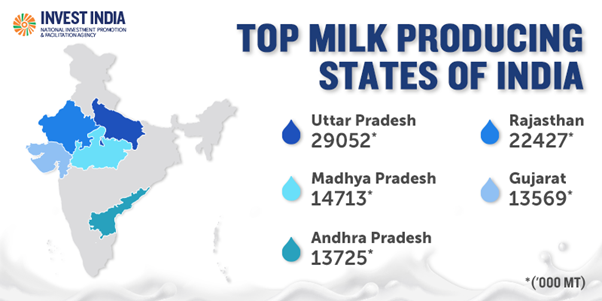
Source:
Image source:
Indian National Army
- Context: The Indian Prime Minister recently condoled the passing away of the distinguished INA Veteran from Malaysia, Anjalai Ponnusamy.
- Azad Hind Fauj or the Indian National Army (INA) was formed in 1942 by Rash Behari Bose and Captain-General Mohan Singh.

- Later, INA was revived by Subhas Chandra Bose to secure India's complete Independence from British Raj.
- On October 21, 1943, Bose set up a provisional government of free India, which declared war on USA and Britain, and was recognized by the Axis powers, as well.
- In 1945, the INA was part of the Japanese deployments during the ‘Burma Campaign,’ which was a series of battles held in the British colony of Burma.
- Unfortunately, the INA soldiers and the Japanese army were overpowered by the British forces.
- On August 15th, 1945, the surrender of Japan in Second World War, resulted in INA's surrender.
- Despite INA failing to achieve its goal, it impacted and expedited the pace of India's freedom struggle in coming years.
Source:
- Indian National Army
- Amrit Mahotsav: How Netaji Subhas Chandra Bose Helped To Revive, Lead Indian National Army In Singapore
Image source:
Saint Kabir
- Context: Indian President has recently inaugurated Sant Kabir Academy and Research Centre in Uttar Pradesh.
- Saint-poet Kabir was born in 1440, at Varanasi in Uttar Pradesh.
- In early life he became a disciple of the 15th-century Hindu ascetic Ramananda.
- Although Kabir is often depicted in modern times as a harmonizer of Hindu and Muslim belief and practice, it would be more accurate to say that he was equally critical of both, often conceiving them as parallel to one another in their misguided ways.
- Kabir’s principal medium of communication were songs called padas and rhymed couplets (dohas), sometimes called “words” (shabdas) or “witnesses” (sakhis).
- Various religions have defined him vividly:
- For Sikhs he is a precursor and interlocutor of Nanak,
- Muslims place him in Sufi(mystical) lineages, and
- For Hindus he is a Vaishnavite (devotee of the god Vishnu) with Universalist leanings.

- He helped shape the Kabir Panth, a sect found across northern and central India that draws its members especially, but not exclusively, from the Dalits.
- Kabir tried to remove superstitions, evils and discrimination from society.
- Though born in a poor and deprived family, he never considered the deprivation as his weakness, but made it his strength.
Source:
Image source:
The Ukraine conflict has raked up old dilemmas: Indian Express
Essence: Need to ensure energy security is among the top priority of every politician who runs a government. They face the dilemma of balancing immediate demand for access to cheap and secure energy for their constituents and at the same time ensuring long term economic growth and sustainable development.
The Ukrainian conflict has deepened this dilemma by fragmenting the global oil and gas market and breaking the supply chain.
Sanctions on Russian oil by the United States and European countries have put pressure on the task of ensuring energy security for them. Joe Biden, US President, has gone against its election promise of not allowing drilling for oil and gas on federal lands.US and Italy are thinking of taking desperate measures like creating an oil consumers cartel.
Increasing oil prices has put Indian leaders into a tight spot, forcing leaders to follow de facto administered pricing regime by not allowing oil marketing companies to increase prices. Ultimately the government will have to pay for these losses but currently politics is getting an edge over economics. Government is also planning to buy LNG fields in the Siberian region of Russia however the plan is not immune from problems arising from sanctions on Russia by the West.
It is prudent for the governments to take into account the bigger picture of ensuring long term energy security and environmental sustainability while avoiding playing petty politics.
Why should you read this article?
- To understand the energy crisis perpetuated by the Ukrainian conflict.
Source:
Do we need a separate ministry to combat the climate crisis?: Hindustan Times
Essence: This year, the theme of the world environment day is – Only One Earth. This is not a new concept and our civilisational values have instituted a strong sense of gratitude for respecting mother nature.
The author stresses on the current climatic distress. The IPCC report has painted code red for humanity, stating that the window for action is limited to only one and half decades from now.
The daunting task of combating the climate crisis needs drastic institutional change. India committed to achieve net-zero by 2070 at CoP26. However, the target is big and the present institutional structure for achieving this is hugely inadequate.
The author expresser various aspects where India can focus for effective mitigation of climate change distress. India needs to focus on factors like Human resources, Trans-disciplinarity and coordination with other line ministries, and a separate ministry to combat the climate crisis that directly reports to the PM's office, works in coordination with other ministries, and has separate state-specific arms that deal with the issue head-on.
Why should you read this article?
- To understand the administrative gaps in addressing climate change in India
- To know the possible reforms to address the gaps
Source:
Waste Solar Panels to Sustainable homes
Background
- By 2030, the Government of India believes that solar energy will contribute almost 300 gigawatts (GW) to its renewable energy target of 450 GW.

- However, India does not yet have a coherent policy on retrieving and managing waste that results from used solar panels or from the manufacturing process.
- All that is available in India is a blueprint issued by the Ministry of New and Renewable Energy.
A solution to the problem of waste Solar panels
- Some estimates suggest that by 2030, India will have more than 200,000 tonnes of solar waste. These solar cells contain lead, cadmium and other toxic materials that are carcinogenic. When they are dumped in landfills without processing, various studies have shown that they leach out into the soil, cause soil degradation, enter the groundwater, harm the fauna around it and cause adverse health problems.
- A team of researchers at the Centre for Sustainable Technologies (CST), operating out of the Indian Institute of Science (IISc) in Bengaluru, is exploring whether old discarded solar panels can be upcycled as a building material.
- One of the motivations for researchers at CST in examining decommissioned solar panels as a building material is because they comprise materials that are inherently very durable.
- The main quality of these solar panels as a building material is that they use toughened glass on one side. These are designed to withstand wind loads, and hail and by and large, they are very durable.
Quote: “There must be a better way to make the things we want, a way that doesn’t spoil the sky, or the rain or the land” - By Paul McCartney
Source:
Share the article
Get Latest Updates on Offers, Event dates, and free Mentorship sessions.

Get in touch with our Expert Academic Counsellors 👋
FAQs
UPSC Daily Current Affairs focuses on learning current events on a daily basis. An aspirant needs to study regular and updated information about current events, news, and relevant topics that are important for UPSC aspirants. It covers national and international affairs, government policies, socio-economic issues, science and technology advancements, and more.
UPSC Daily Current Affairs provides aspirants with a concise and comprehensive overview of the latest happenings and developments across various fields. It helps aspirants stay updated with current affairs and provides them with valuable insights and analysis, which are essential for answering questions in the UPSC examinations. It enhances their knowledge, analytical skills, and ability to connect current affairs with the UPSC syllabus.
UPSC Daily Current Affairs covers a wide range of topics, including politics, economics, science and technology, environment, social issues, governance, international relations, and more. It offers news summaries, in-depth analyses, editorials, opinion pieces, and relevant study materials. It also provides practice questions and quizzes to help aspirants test their understanding of current affairs.
Edukemy's UPSC Daily Current Affairs can be accessed through:
- UPSC Daily Current Affairs can be accessed through Current Affairs tab at the top of the Main Page of Edukemy.
- Edukemy Mobile app: The Daily Current Affairs can also be access through Edukemy Mobile App.
- Social media: Follow Edukemy’s official social media accounts or pages that provide UPSC Daily Current Affairs updates, including Facebook, Twitter, or Telegram channels.

